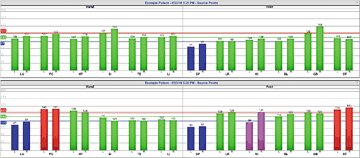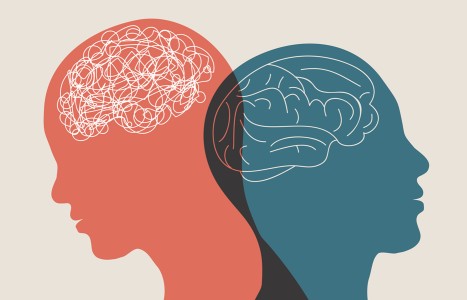Consequences for HIPAA violations can often be quite harsh. If someone has breached the HIPAA privacy regulations – even without any malicious intent, civil penalties are applicable: $100 per violation for unawareness, a minimum of $1,000 for reasonable cause, a minimum of $10,000 if willful neglect is present and then rectified, and finally, a minimum of $50,000 for individuals who act with willful neglect and ignore the issue.
| Digital ExclusiveInnovation in Acupuncture Through Digital Meridian Imaging
As a rookie acupuncturist in dire need of cheap CEU's, I grudgingly showed up for a seminar on digital meridian imaging that offered 16 credits. As a recent graduate, I was full of myself and "the way" of Traditional Chinese Medicine. Traditional Chinese Medicine stresses one must do a full intake, delve into every possible symptom to ascertain the correct diagnosis for proper treatment protocols that address the root cause of disease. Anything less was a detriment to the patient and to the profession, I thought with my puffed-up ego.
As I waited for the seminar to start I realized that most of the other 50 attendees were chiropractors or naturopaths with 100-300 hours of acupuncture training. I thought these people were just selling yet another device so DCs didn't have to think about what points to use – they could have their office staff perform the two-minute procedure, stick needles in the recommended points and - presto! "valid" acupuncture, complete with pretty charts and explanations. I almost walked out in disgust and indignation.
Resistive, I listened to what they had to say. The history was valid. The research was solid. From a Chinese medical perspective, what they taught made more sense than I wanted to admit. I became intrigued with the technology. Could it assist me in being a better practitioner? The concept of showing the patient objective and measurable information about their meridian status over time would be priceless for patient retention.
What is Digital Meridian Imaging™ (DMI)?
DMI is the process of measuring the electrical resistance of acupuncture points and placing the results in mathematical algorithms based on OM theory to produce diagnostic graphs and charts. It's not a far leap from the familiar EKG or EEG used extensively in allopathic medicine. The DMI concept is based on the concurrent and independent measurement discoveries of acupuncture points by Japanese doctors Yoshio Nakatani and Kobei Akabane and German doctor Reinhold Voll in the early 1950s.
These scientific discoveries have led to a small number of robust DMI software programs available today: the Bio-meridian, the Electrical Meridian Imaging (EMI) and the AcuGraph®.
My next action was to purchase the software and challenge it myself. I took the patient's reading with the AcuGraph and compared it to my diagnoses. It was correct 100 percent of the time. How could this be?
Worse, when the odd patient didn't respond as expected and I changed the treatment protocol to what the software presented, they got better! I'm a solid practitioner – what was I missing? It took me a number of months to realize that like any health issue, the root cause has to be bad enough (50+ percent) for signs or symptoms to appear – even in Chinese Medicine. Although the symptoms were not yet discernible through questioning, the software was registering it.
I became certified on the Bio-Meridian and the AcuGraph. The Bio-Meridian is a complicated machine that addresses homeopathic, nutrition, and condition remedies - well beyond OM. The AcuGraph and the EMI are created and focused on OM specifically.
I prefer the AcuGraph after investigating the other DMI brands. It is my opinion that the AcuGraph is - by far - the most accurate and superior DMI software available on the market for the OM practitioner. As with any purchase, consider price, quality, features, support, warranty and upgrades when you shop.
How Does DMI Work?
Understanding that acupuncture points and channels conduct electricity differently than the surrounding skin, Dr. Nakatani discovered that anomalies in electrical resistance measurements indicated meridian dysfunction. He developed acupuncture treatment protocols to balance qi in the meridians and termed the process Ryodoraku.
DMI uses these same principles combined with modern statistical analysis to measure electrical resistance and correlate the results with abnormalities in qi flow. The software then produces summary information and recommendations in charts and graphs.
Since Dr. Nakatani's pioneering work, numerous studies and technique refinements have given validity to skin resistance measurements in acupuncture patient assessment www.RyodorakuResearch.com.
The DMI in Practice
The software-guided, two minute exam measures either the Jing-Well or Yuan Source points for three seconds each with a handheld probe.
The exam results are displayed in a graphical format and categorized as high, low, normal, or split. Split means that the left and right measurements of the same meridian vary considerably, indicating an imbalance in that channel (GB channel, in purple below).
Baseline Graph

The results may be viewed in eight different graphs; Baseline, Yin/Yang, Element Pairs, 5-Element, Energy Cycle, Horary Cycle, Analysis Ratios, or P.I.E. (personal integrated energetics). I favor Dr. Tan's techniques, therefore I prefer the P.I.E. chart, which is the opposite clock format. I can add notes to the exam, removing the need for paper records.
The software provides six acupuncture treatment protocols: Basic, Advanced, Expert, Auricular, Back-shu, and Divergent channels, plus a place to insert your own protocol.
The AcuHerb section incorporates 22 commonly used Chinese formulas into the DMI algorithms, which provides recommendations. The herbal formula actions, indications, contraindications, comments, ingredients, and pharmaceutical interactions are included in the database. The software also tracks which formulas I prescribe and manages my AcuHerb inventory.
There may be recommended treatments for the patient to do at home, such as stimulating the Jing-Well points (printable image provided).
A comprehensive reference section includes acupuncture points with locations, attributes, actions, indications, needling information, and cautions, including a color image of a real body with clear and accurate point locations, a chart section with charts of common body and auricular points, and a treatment list of common conditions with suggested point protocols.
The history function displays the patient's results over time using a line chart to easily see how the patient has progressed from the initial reading to today. This is an invaluable tool for helping the patient objectively see how they have improved instead of subjectively relying on how they feel or using the 1-10 point scale.

History Graphs
The history function displays the patient's element results so, for example, you can track their water element fluctuating wildly in relation to their fire element (severe menopause). As the patient's symptoms are controlled, it shows their elements becoming stable.
The comparison function compares past exam results side-by-side. This might be used to see how the patient presents differently in the beginning of a month versus the middle of the month, during their menstrual cycle, before and after significant events in the patient's life, or to see how they have changed since first being seen.
Comparison Graph

The evidence-based text report gives a short explanation of the channel functions, the patient's results, what those results mean and probable signs and symptoms the patient may experience. I am amazed that the majority of patients bring back the paperwork with notes and highlighter marks to tell me what they have been experiencing that week. It really gets their head around OM and involves them in their healing on a level that only reading allows—if it's in print, it's true!
Other features include an optional data back-up service, free technical support, an information blog for practitioners, easy installation, superb training, and free upgrades.
Marketing
The most useful marketing DMI function is the ability to print or email results and graphs to the patient. Nothing beats this visible, objective proof of the patient's progress and, in effect, my effectiveness as their healer.
Many practitioners find DMI valuable for attracting new patients by demonstrating the DMI in public. People are familiar with the evidence-based western medical model. DMI provides evidence-based reports and treatment in a scientific and technological format that people can comprehend, rather than an ancient and mysterious "medicine".
People like to see their results and findings and you don't have to convince them of their progress; it's right there in full-color graphs!
Using DMI provides better diagnostic information than questioning alone. The system is an ally, saving time, providing key information and keeping it organized.
Acupuncture for Dummies?
No! Using this tool doesn't replace the practitioner's clinical skills. It's a tool to be used with wisdom and skill like any other tool. You absolutely need your ability and knowledge to interpret the DMI graphs correctly, to determine which herbal formula is best, to choose the appropriate treatment plan, and to manage the patient's care.
I find DMI to be an indispensible addition to the clinical practitioner to save intake time, provide marketing, help the patient understand OM by providing objective evidence for the patient's healing journey, and challenging the practitioner's skills.
I hope you are more open minded than I was when considering acupuncture technology tools. I might have missed a key instrument in the future of OM if it hadn't been for that fateful day years ago. I encourage you to investigate the DMI yourself. You'll be glad you did.
Editor's Note: Monique Smith has no financial interest in any of the products, companies or websites mentioned in this article.


